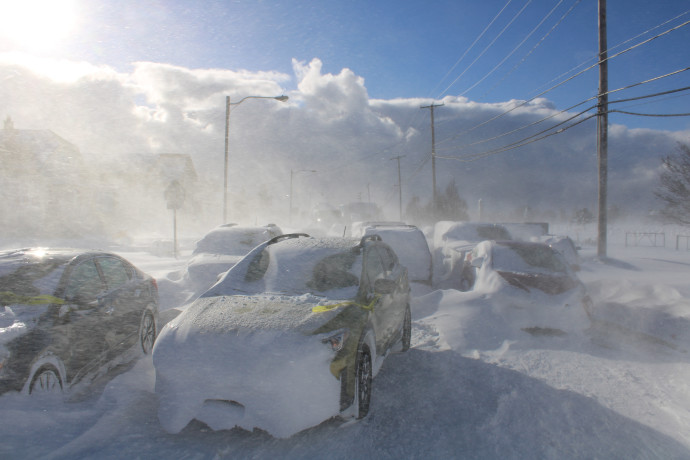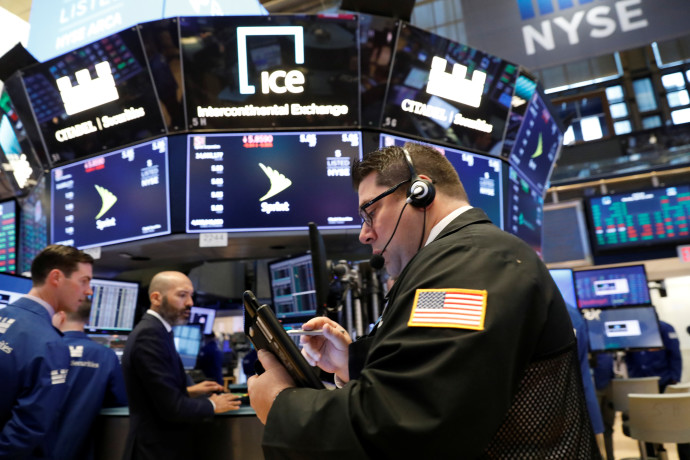The stock market is bleeding, billions are being wiped out, tech stocks are plummeting, cryptocurrencies are crashing and more: 2022 was a year of drama in the financial markets.
The COVID-19 pandemic that refuses to go away, inflation, the war in Ukraine, an energy crisis, disruptions in supply chains that are still ongoing, a drop in American consumer confidence, interest rate hikes, faltering wages, falling stocks and unrealized profit forecasts - all of these were reflected in economic reality this year.
It was a challenging year, to say the least, where you didn't have to be a big businessman to lose money. No citizen did not "bleed" through their pension funds, deposits - or on the other hand, through a negative bank balance or a mortgage that became more expensive.
After summarizing the mindset in a few sentences, we will embark on a journey between the stations where the global economy stopped in 2022.
When was the last time you've seen a bull?
The S&P 500 index, which entered bearish territory this year, faithfully reflected the state of the energy sector, due to a decrease in the supply of energy products on account of the war in Ukraine. Large and small stocks have also suffered this year, and contrary to popular belief that bond prices usually fare better in difficult conditions, these have also fallen this year due to increasingly high-interest rates.

According to the Wall Street Journal, the 10-year US government bond posted its worst performance in 234 years. As a result, the traditional 60/40 stock/bond portfolio split did not cushion the decline.
November also saw the collapse of several major tech stocks that have lost a combined $3.4 trillion in market value since the start of 2022 — including a $1 trillion drop in one week. The shares of "FAANG" - Facebook, Amazon, Apple, Netflix and Google fell sharply due to inflation and interest rate increases.
Facebook, for example, fell 26% in one day in February and its market value fell by more than $230 billion, which is now considered the largest write-off in the history of the stock market. Meta, which was worth more than a trillion dollars last year, is currently worth only about $327 billion.
This year also saw several bubbles burst: the crypto and NFT bubble collapsed due to changes in the prioritization of risk over speculation. Stocks that enjoyed an inflated setup and excessive demand experienced a painful correction. And as if to sum up the terrible year on a particularly harsh note, the FTX crypto exchange went bankrupt in November.
The collapse of one of the world's largest crypto exchanges has shaken the market. Crypto stocks lost two-thirds of their value, while the total crypto market cap plunged below $1 trillion. Customers and investors have lost billions of dollars, and will likely never see the money, according to FTX's new CEO.

Elon Musk buys Twitter
The world's second-richest person said in early 2022 that he wanted to buy one of the world's most popular social media platforms — then changed his mind. And again he changed his mind. Then, he finally announced that he wanted to purchase Twitter.
The saga began in January when Elon Musk began investing in Twitter, which has 230 million users. In April, the purchase deal was signed, but in the weeks that followed, Musk raised concerns about spam accounts on the platform and claimed that Twitter had provided him with an inaccurate estimate of their numbers.
In May, Musk said the deal was temporarily "on hold" over the issue, and some argued that it was just an excuse the billionaire entrepreneur was using to pull back amid the plunge in capital markets, particularly in the technology sector.
In July, Twitter shares fell 11% after Musk said he was canceling the deal. On October 21, the stock fell 5% to $49.88 after reports of a federal investigation into the acquisition deal. On October 28, Elon Musk completed the deal worth $44 billion, or $54.20 per share.
In the days after the purchase, Musk fired the company's senior managers and half of the staff (7,500 people), established a content monitoring committee, and changed Twitter's subscription service so that it would cost $8 a month for those interested.
On December 13, the market research company Insider Intelligence published a forecast, according to which more than 30 million users will leave Twitter in the next two years, due to concerns about the spread of false and offensive information following the acquisition.
Monthly users are expected to fall 4% in 2023 and 5% in 2024 — more than 32 million in total — the first annual decline in user numbers since Insider Intelligence began monitoring Twitter in 2008. The largest decline in the number of users is expected to occur in the United States, Twitter's largest market, and at the end of 2024, there will be 50.5 million American users on the platform - the lowest figure since 2014.
According to the forecast, growth in advertising revenue on Twitter will also drop to "zero" in the next two years, amid advertiser concerns about brand safety while the company becomes increasingly "unstable and less pleasant."

Europe and North America freeze in the shadow of the energy crisis
Energy markets began to tighten in 2021 due to a variety of factors, including an accelerated economic recovery after the COVID-19 pandemic. But the situation escalated dramatically and developed into a global energy crisis after Russia's invasion of Ukraine in February 2022.
The price of natural gas soared to a record high, and as a result the price of electricity also increased. The price of a barrel of oil has reached its highest level since 2008.
High energy prices have contributed to high inflation, pushed families below the poverty line, forced factories to reduce output or stop operations altogether and slowed economic growth to the point where fears of a deep recession arose in some countries, such as the United Kingdom.
Europe, which depends on Russia as a source of gas supply, has already decided to implement gas rationing this winter, while many developing economies are registering a sharp increase in the cost of importing energy products and fuel shortages.
Manufacturing plants that operate on gas in Europe reduced output because gas costs became too expensive, while in China some plants cut off the electricity supply entirely.
In developing economies, where the share of the household budget devoted to energy and food is already high, the poverty rate has soared. Even in developed economies, the rise in prices affected low-income households and caused economic, social and political pressures.
The Russian invasion of Ukraine exacerbated the situation. The United States and the European Union have imposed a series of sanctions on Russia, and many European countries have announced their intention to end dependence on Russian gas completely.
At the same time, Russia began to limit and even completely cut off the supply of gas through export pipelines. Russia is the largest exporter of fossil fuels in the world, and a major supplier to Europe. In 2021, a quarter of all energy consumed in the EU came from Russia.
While Europe is trying to replace Russian gas, the prices of American, Australian and Qatari natural gas have soared. Because the price of electricity - similar to the price of fuel which depends on oil - depends on the price of gas, electricity prices also skyrocketed.
In addition, the desire to break away from dependence on Russia in Europe, the United States and Asia, and the sanctions imposed on the country, led to the fact that many tankers did not agree to transport Russian oil and large non-Russian oil producers were unable to increase output to meet the growing demand. Recently, energy prices have come off their highs, but the outlook is uncertain.
At the beginning of November, the International Energy Agency (IEA) published a forecast according to which Europe should act immediately to avoid a shortage of gas in 2023, in light of the cessation of supplies from Russia and an increase in demand in China.
In addition, the individual economies are much more interconnected than they were 50 years ago - which amplifies the impact of the crisis. For this reason, the crisis can now be called the first global energy crisis.
One silver lining is that the current energy crisis may accelerate the development, market entry and adoption of sustainable and clean renewable energies, such as wind and solar, as the energy crisis of the 1970s did to the field of energy efficiency.
However, although the crisis today shares some common characteristics with the crisis in the 1970s, there are significant differences between the two. The crisis today concerns fossil fuels, back in the 70s it was limited to oil while the global economy depended mainly on oil, and less on gas.

Inflation rears its head, interest rates rise
One of the big economic stories of 2022 was high inflation. All products, from fuel and food to entertainment, were more expensive this year. The Federal Bank took steps aimed at curbing the increase.
At the same time, the rate of salary growth did not manage to catch up with the rate of inflation, which reduced the budget of all of us. Economists and citizens alike are wondering whether inflation is here to stay and how much the Fed will raise interest rates in its war against the rising cost of living.
Before the outbreak of the COVID-19 pandemic, inflation was low for three decades, when the inflation rate of 5.4% in the United States in the 90s was the highest, and most of the time inflation was about 2% - the target of the Federal Bank. However, as the pandemic began to subside, inflation began to rise.
In 2022, there was no slowdown in the rate of inflation and it recorded a record in June of 9.1%. From July, inflation began to decrease slightly, and in November it stood at 7.7%. Initially, many believed that this was temporary inflation because it was a response to the drop in inflation during the pandemic.
Disruptions in supply chains and price increases in some sectors of the economy, such as used cars, exacerbated the situation. The Federal Reserve Bank expected prices to return to normal levels shortly - but this did not happen.
Another factor that contributed to inflation is the decision of the Organization of Petroleum Exporting Countries (OPEC) to cut oil output by two million barrels per day, which immediately led to a spike in fuel prices. This is the largest cut by the organization since the outbreak of the pandemic.
The Federal Reserve Bank is supposed to maintain a high level of employment and a reasonable rate of inflation. The bank's inflation target is 2% - and when this threshold was crossed, the bank realized that it had to take steps to curb the increase in prices.
The interest rate set by the Federal Bank was for years, until recently, 0% - the result of the global financial crisis in 2008 and the monetary policy implemented by the bank to stabilize the economy after it.
The bank began to raise the interest rate as part of the attempt to curb the rise in prices, despite criticism that it was its monetary policy that contributed to the high inflation. In 2022, the bank raised the interest rate seven times and now it stands at 4.5%. Central banks around the world, which had kept interest rates at 0% for years, followed the Bank of America's lead, raising interest rates as well.
